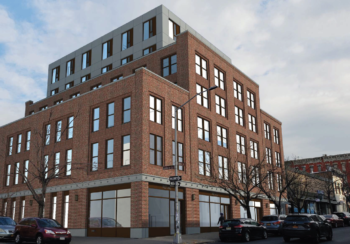
Proposed Rendering of 171 Calyer Street./Image Credit: PKSB
Landmarks agreed with local elected officials and residents that the proposed building was out of context for the Greenpoint Historic District. On February 11, 2020, the Landmarks Preservation Commission held a public hearing on a Certificate of Appropriateness to demolish an existing one-story brick building and construct a new seven-story mixed-use residential and commercial building at 171 Calyer Street, located within the Greenpoint Historic District in Brooklyn. The existing one-story building was a former supermarket and is located on the corner of Calyer and Lorimer Streets.
The proposed building is seven stories tall, rising to a height of 74 feet and 8 inches. The building has multiple setbacks as it goes up. Sherida Paulsen of PKSB, the project’s architectural firm, stated that the multiple setbacks in the building’s design was intended to reduce the massing. Two different materials are used for the building’s façade. On the first through part of the fifth floor, the façade facing Calyer and Lorimer Streets is made with brick with light colored mortar. The façade for the remainder of the fifth floor, sixth floor, and seventh floor is made with light gray metal panel. The building’s east façade is made from light gray metal panels. There is a bulkhead at the top of the building that rises to a height of seven feet and eight inches.
On the façade facing Calyer Street, the ground floor has three retail entryways and one residential entryway. Each retail entryway is outlined with copper colored metal and the residential entryway is made from light gray metal with a projecting canopy above the door. There are recessed painted metal simulated double hung windows that span the façade of the second, third, fourth, and part of the fifth floor. There are eight windows on the second and third floors, six windows on the fourth floor, and four windows on the fifth floor. A corbelled brick parapet lines the top the third, fourth, and fifth floors. Four painted metal windows span the sixth and seventh floor façade.
On the façade facing Lorimer Street, the ground floor has a parking garage entryway, a residential egress door, six windows, and a three panel window for one of the retail spaces. There are four recessed areas with six windows in each area that span the second and third floor façade. There are eight windows that span the fourth and fifth floor façade. A painted metal guard rail lines the top of the fifth floor. There are six painted metal windows that span the sixth and seventh floor façade.
The Greenpoint Historic District mostly comprises of two to four-story residential frame houses, row houses, and flat houses designed in the Italianate, Neo-Grec, and Romanesque Revival styles. Prominent design details include brick or brownstone façades, simple round-arched door enframements, arched windows, and iron cornices. The district also has commercial buildings and residential buildings with ground floor commercial space and these buildings are around one to four stories. They are primarily located on Calyer Street, Greenpoint Avenue, and Manhattan Avenue. The Greenpoint Savings Bank building, a neo-Romanesque domed building, is also located within the district on the corner of Calyer Street and Manhattan Avenue. PSKB told CityLand that the Greenpoint Savings Bank building rises to a height of 70 feet.
At the hearing, Paulsen stated that although the proposed building is taller than most of the buildings within the district, its size is comparable to the Greenpoint Savings Bank building and several six-story buildings located near the historic district. She also stated that the size of the proposed building is about the same as the former Greenpoint Theatre that used to be on the project site. PSKB told CityLand that they estimated the former theater building to be about 70 feet.
At the public hearing, local Council Member Stephen Levin, representatives from local Assembly Member Joseph Lentol and State Senator Brian Kavanagh’s offices, and Greenpoint residents urged Landmarks to oppose the proposed building because the bulk, height, and mass are out of context for the historic district, the proposed details do not fit in with the character of the historic district, the buildings used to justify the proposed building’s size and height are not appropriate references, and the approval of the project would set a precedent to build taller buildings that would destroy the historic district’s character.
Landmarks believed that demolition of the existing building was appropriate. However, they agreed with the testimonies and stated that the proposed building’s massing, height, and details are out of context for the historic district. The Commissioners noted that they supported the concept of a larger building on the site but not one as large as the proposed design.
Vice Chair Frederick Bland and Commissioner Diana Chapin stated that the metal panels on the top floors are too white. Commissioner Michael Devonshire stated that the building looks too industrial for the historic district and the building’s design would change the district’s character.
The Commissioners also agreed that using the non-existent Greenpoint Theatre and larger buildings near the district as references to justify the size of the proposed building was inappropriate.
Landmarks did not take any action on the application. Chair Sarah Carroll stated that the applicant team needs to work with Landmarks staff to rethink the building’s height, massing, and details. She also stated that the applicant team needs to change the industrial character of the proposed building’s top two floors.
By: May Vutrapongvatana (May is the CityLaw Fellow and New York Law School Graduate, Class of 2019).

